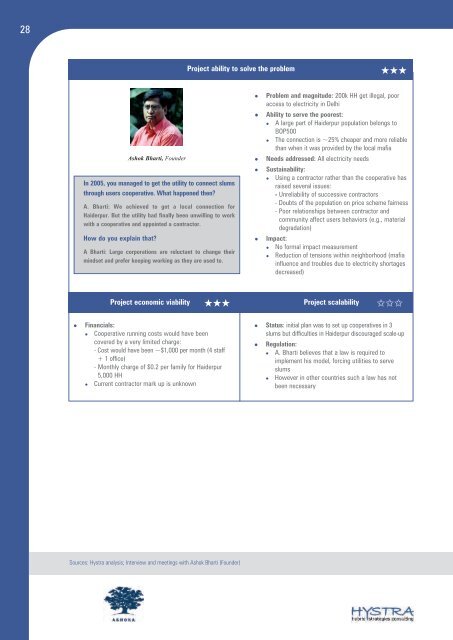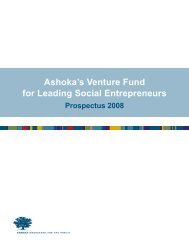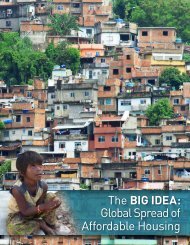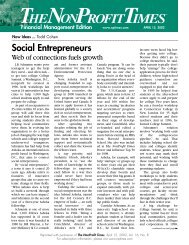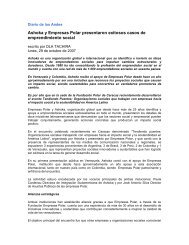Access to Energy for the Base of the - Ashoka
Access to Energy for the Base of the - Ashoka
Access to Energy for the Base of the - Ashoka
You also want an ePaper? Increase the reach of your titles
YUMPU automatically turns print PDFs into web optimized ePapers that Google loves.
28<br />
In 2005, you managed <strong>to</strong> get <strong>the</strong> utility <strong>to</strong> connect slums<br />
through users cooperative. What happened <strong>the</strong>n?<br />
A. Bharti: We achieved <strong>to</strong> get a local connection <strong>for</strong><br />
Haiderpur. But <strong>the</strong> utility had finally been unwilling <strong>to</strong> work<br />
with a cooperative and appointed a contrac<strong>to</strong>r.<br />
How do you explain that?<br />
� Financials:<br />
Ashok Bharti, Founder<br />
A Bharti: Large corporations are reluctant <strong>to</strong> change <strong>the</strong>ir<br />
mindset and prefer keeping working as <strong>the</strong>y are used <strong>to</strong>.<br />
Project ability <strong>to</strong> solve <strong>the</strong> problem<br />
� Problem and magnitude: 200k HH get illegal, poor<br />
access <strong>to</strong> electricity in Delhi<br />
�� Ability <strong>to</strong> serve <strong>the</strong> poorest:<br />
� A large part <strong>of</strong> Haiderpur population belongs <strong>to</strong><br />
BOP500<br />
� The connection is ~25% cheaper and more reliable<br />
than when it was provided by <strong>the</strong> local mafia<br />
� Needs addressed: All electricity needs<br />
� Sustainability:<br />
� Using a contrac<strong>to</strong>r ra<strong>the</strong>r than <strong>the</strong> cooperative has<br />
raised several issues:<br />
- Unreliability <strong>of</strong> successive contrac<strong>to</strong>rs<br />
- Doubts <strong>of</strong> <strong>the</strong> population on price scheme fairness<br />
- Poor relationships between contrac<strong>to</strong>r and<br />
community affect users behaviors (e.g., material<br />
degradation)<br />
� Impact:<br />
� No <strong>for</strong>mal impact measurement<br />
� Reduction <strong>of</strong> tensions within neighborhood (mafia<br />
influence and troubles due <strong>to</strong> electricity shortages<br />
decreased)<br />
Project economic viability ★★★<br />
Project scalability<br />
� Cooperative running costs would have been<br />
covered by a very limited charge:<br />
- Cost would have been ~$1,000 per month (4 staff<br />
+ 1 <strong>of</strong>fice)<br />
- Monthly charge <strong>of</strong> $0.2 per family <strong>for</strong> Haiderpur<br />
5,000 HH<br />
� Current contrac<strong>to</strong>r mark up is unknown<br />
Sources: Hystra analysis; Interview and meetings with Ashok Bharti (Founder)<br />
★★★<br />
� Status: initial plan was <strong>to</strong> set up cooperatives in 3<br />
slums but difficulties in Haiderpur discouraged scale-up<br />
� Regulation:<br />
✩✩✩<br />
� A. Bharti believes that a law is required <strong>to</strong><br />
implement his model, <strong>for</strong>cing utilities <strong>to</strong> serve<br />
slums<br />
� However in o<strong>the</strong>r countries such a law has not<br />
been necessary


